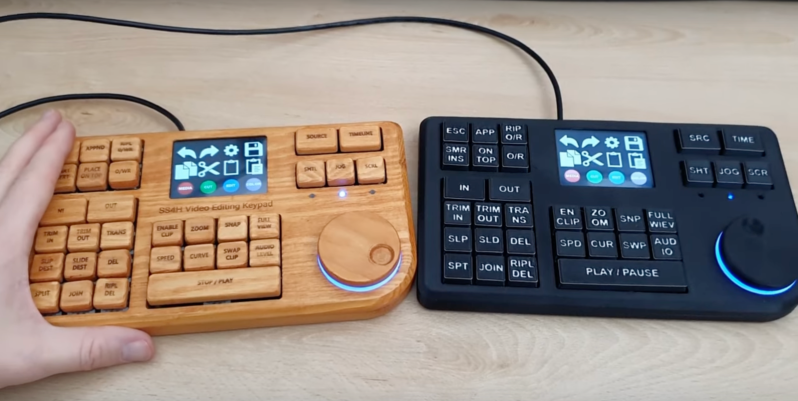Editing video tends to involve a lot of keyboard shortcuts, and while this might be fine for the occasional edit, those who regularly deal with video often reach for a macro pad to streamline their workflow. There are plenty of macro keyboards available specifically meant to meet the needs of those who edit a lot of video, but if you want something tailored for your personal workflow you may want to design your own keyboard like this wooden macro pad from [SS4H].
The keyboard itself is built around an STM32 microcontroller, which gives it plenty of power to drive and read the keyboard matrix. It also handles an encoder that is typically included on macro keyboards for video editing, but rather than using a potentiometer-type encoder this one uses a magnetic rotary encoder for accuracy and reliability. There’s a display built into the keyboard as well with its own on-board microcontroller that needs to be programmed separately, but with everything assembled it looks like a professional offering.
[SS4H] built a prototype using 3D printed parts, but for the final version he created one with a wooden case and laser etched keys to add a bit of uniqueness to the build. He also open-sourced all of the PCB schematics and other files needed to recreate this build so anyone can make it if they’d like. It’s not the only macro keyboard we’ve seen before, either, so if you’re looking for something even more esoteric take a look at this keyboard designed to be operated by foot.
















Pretty nice, and gracious of him to make the files available.
Having said that I consider this to be out of my budget for such things at the moment, with all the equipment needed.
Very nice they shared this project and the PCB files. Magnetic is better than potentiometer by far so nice choice there too.
Curious if there is a parametric CAD tool that can generate keyboard layouts and resulting PCB and 3D print files quickly? So many times you see these they wind up being a huge project which starts from scratch. Surely there are faster and more accurate ways to do this?
Wood is cheap but typically porous and will not hold up well over time to frequent use but it looks kind of nice? Don’t get it wet though and it is porous. Not entirely sure why they 3D printed it and then made a wood version? I guess you could PU seal it? Don’t suggest epoxy sealing a keyboard.
Why not the other way around though? Wood prototype and 3D printed version to use? No judgement, just curious.
That is gorgeous!
It is phrased odd, a potentiometer≠encoder.
Thanks for posting my project! I hope you guys like it.
If you have any questions (or comments), don’t hesitate to ask. I will be happy to answer :)
Thank you for sharing all the work! That is a great amount of effort, indeed! It looks beautiful!
Eh there’s analog encoders that output a voltage signal to indicate angle. Sounds like a pot to me
https://en.wikipedia.org/wiki/Rotary_encoder#Data_output_methods
Oh, you know. It’s little box that’s got a rotating shaft that you can put a knob on, and three pins or lugs coming out the bottom, and another two pins for a switch. Looks like a potentiometer. Smells like a potentiometer. A user twiddles (or frobs) it like a potentiometer. But it’s an encoder. Ergo, it’s a potentiometer-type encoder.
It is a rotary encoder at least as it rotates 360+ degrees? On traditional video edit controllers it would be a different device; that would rotate 360 or depressed a variable forward / reverse speed; that’s what the buttons above the wheel implement.
@Might as well just toss a Pi of some type in there too?
Yeah wood has its issues, and I think I’d go with bamboo if I were him, that has properties that seem more suited than wood but looks like wood. (I’m told that technically it’s a form of grass.)
I love using non standard materials for electronic gadgetry. Something I’ve always wanted to mess around in but so far have lacked the time.
The keyboards look great, thanks for sharing the build!
Very nice aesthetic
… got wood lol really though, have you heard the term overachiever? because it’s know who [i]you[/i] are, and it’s embarrassed by it’s shortcomings lol
that’s a sexy piece of kit you cobbled together, sir.